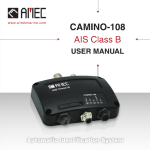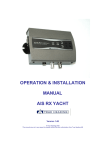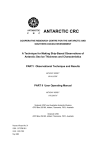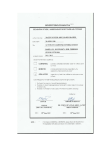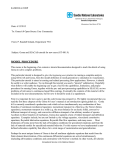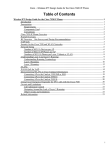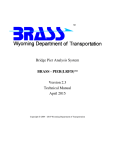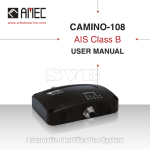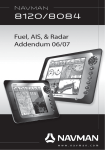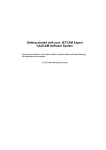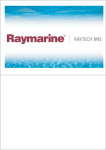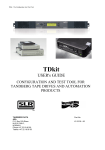Download downloadable PDF version - United States Power Squadrons
Transcript
ELECTRONIC NAVIGATION TOOLS Chapter 6 INTRODUCTION Note: The next update to the Advanced Piloting Manual will include a brief description of and introduction to the material which follows. This downloadable version is available for anyone who desires it. Instructors are welcome to download and print this material for their AP students. The marvels of the electronics revolution have profoundly changed the way we live our lives, and the profusion of electronic devices has become so commonplace that we expect to find new, better, cheaper, and more efficient electronic devices arriving in the marketplace almost weekly. Few realize that this revolution began over 100 years ago, in 1904, when John Ambrose Fleming patented the first electronic device, a thermionic diode or vacuum tube that converted an alternating current into a direct current. This was followed in 1906 by Lee DeForest's invention of the audion tube, a three-element vacuum tube that amplified electronic signals. Continued innovation in this technology led to the development of radio, television, high quality audio recording and reproduction systems, long distance telephony, RADAR and early computers. However, vacuum tube technology used a great deal of power, was bulky, expensive, and prone to failure. These limitations were overcome with solid-state technology, which was launched in 1948 when William Shockley, Walter Brattain, and John Bardeen, working at the Bell Telephone Laboratories, invented the transistor, leading to smaller, cheaper, more reliable devices that required less power. From that moment on the revolution accelerated at an exponential rate. Single transistors evolved into multiple transistors arranged on a single silicon chip and connected internally. These chips evolved into integrated circuits capable of performing the most sophisticated tasks at enormous speed and at low cost. The integrated circuit made possible microprocessors that enabled the development of an instrument that has changed the world's view of itself, and added enormous fuel to the explosive electronics revolution. That instrument is the Global Positioning System (GPS). GPS provides remarkably accurate, continuous position information (Latitude and Longitude) to a user anywhere on earth. GPS has worked its way into all our lives and made location awareness a common daily experience. It is on our boats, cars, cell phones, personal computers, and PDAs. At least one company, Suunto, even produces a watch that contains a GPS along with a barometer, an electronic compass, and a PC link for downloading routes. As GPS becomes omnipresent in our society, its uses in marine applications continue to grow and spread into almost every arena of the mariner's world, replacing old technology and improving the way we navigate, communicate, and operate our boats. Position or location awareness is even finding its way into marine communications, with digital selective calling (DSC) now integrated into our VHF and MF/HF marine radios. 1 Connected to a GPS, these radios can not only send an automated digital distress or safety signal, but can also send the distressed vessel's exact position, along with all information needed for Search and Rescue (SAR) personnel to locate, identify, and rescue the vessel in distress. The Automatic Identification System (AIS), already a requirement for many commercial vessels, is making its way into the recreational boater's world. AIS is a GPS-based location awareness tool that uses a unique communications protocol that permits a virtually unlimited number of close-by vessels to exchange position, speed, heading, identification number, and other vital data over two VHF radio channels. Well-known electronics firms like Furuno, JRC, Shine Micro, and Simrad are already building AIS units intended for the recreational boater. Even the traditional ship's compass now has a GPS alternative; GPS compasses are available from several companies. These electronic instruments not only give position data but also provide heading information even with the boat standing still at the dock. The electronics revolution is even giving the traditional helm an extreme makeover. Consider the display shown here from Transas Marine. This one is designed for the "big ships", but similar displays for the recreational boater are in the near future as the electronics revolution marches on. Transas Marine Flat Screen Helm Display There are other spectacular electronic instruments and systems for mariners; this chapter will discuss them and how you can use them to your advantage. We will begin, however, with the one that has made the most significant impact, the GPS, followed by the other electronic navigation tools available for mariners. The electronics revolution is here and technology is changing fast. This rapid pace of innovation can leave the boat owner uncertain regarding what electronics to buy and how 2 to use them. This chapter is intended to give the boat owner a clear view of some of the options available, and an understanding of how these electronic tools may be used for navigation purposes. THE GLOBAL POSITIONING SYSTE (GPS) GPS is an acronym for Global Positioning System. It is a satellite-based, all weather, radio navigation system that is available to users worldwide, 24-hours a day. GPS is a highly accurate radio navigation system that automatically determines and displays a current location on the screen of a GPS receiver. The current location may be displayed digitally on all GPS receivers, - in latitude and longitude. Today, most GPS receivers have an integrated plotting capability which permits the current location to also be displayed graphically with the boat’s current position depicted as a boat icon on the receiver's screen. Today almost all GPS receivers are Wide Area Augmentation System (WAAS) compatible which greatly increases the positioning accuracy of the GPS system, and may include an integrated chart plotter. Figure GPS-1 is a picture of a portable GPS receiver displaying its current location digitally. Figure GPS-1 Figure GPS-2 is a picture of a mountable GPS receiver displaying its current location graphically. 3 Figure GPS-2 System Description – GPS, as a system, is composed of three distinct segments. These segments are the space segment (the satellites), a control segment (the ground stations operated by the United States Air Force) and the user segment (you with your GPS receiver). The Space Segment, the heart of the system, is normally composed of at least 24 satellites (21 of which are constantly active and three operational spares). These satellites are inserted into six different circular orbital paths or planes10,898 nautical miles above the earth. The orbit period for each GPS satellite is 11 hours and 58 minutes. This orbital configuration ensures that at least six GPS satellites will be in line of sight for most viewers located anywhere on the planet earth. Figure GPS-3 is a graphical depiction of the GPS satellite constellation. Figure GPS-3 The Control Segment consists of one master control station located in Colorado and ten monitoring stations located around the world near the equator. The purpose of the control segment is to provide corrected orbital data (called ephemeris) and corrected clock (time) information to each GPS Satellite. This precise control of the orbital data and clock information ensures that the navigation signal broadcast by each GPS satellite is correct. The User Segment consists of you and your GPS receiver. The GPS receiver converts the navigational signal from visible satellites into position, velocity and time estimates; which are then converted to a position on the earth. The components of the user’s GPS receiver are: antenna, multi-channel receiver, clock, computer, and display/keyboard. The GPS “receiver” includes a powerful computer for processing the digital signals and calculating navigation information. 4 GPS Receivers The GPS receiver is a marvelous navigator whose basic function is to receive and process radio navigation signals from the GPS satellites, and compute a set of coordinates in longitude and latitude for the present position. That all of this can be done with a device that can be held in the palm of one's hand is a tribute to American ingenuity and engineering. In addition to the basic function of positioning information, most GPS receivers have been expanded with additional software/firmware that can be used to supply a vast array of useful information. In considering the use of the GPS for navigation purposes, look first at the basic principles of navigation. The navigation problem can be broken down into five basic questions: 1. Where am I? This can be answered by your GPS. 2. Where do I want to go? This is answered by you. 3. What course or route should I take? If waypoints are used and the answer to question five is “No,” this question can be answered by your GPS. 4. When will I arrive? This can be answered by your GPS, especially if you use enroute waypoints. 5. Are there any hazards enroute (between waypoints) that must be avoided? The navigator can answer this question only after careful examination of the intended route on a nautical chart. GPS does not (cannot) answer this question and automatically pick or suggest a safe route. GPS blindly routes you from waypoint to waypoint with no knowledge of your surroundings. Using Your GPS Receiver. To get the most from your GPS receiver, it is important to read the user's manual that came with your set. It is also important that you take some time to familiarize yourself with the operating features of your GPS receiver, and have some understanding of the functions of the buttons on the keyboard. When you first power up your GPS receiver, you have taken the first step in exploring the wonderful possibilities of electronic navigation. At this point you should be aware that the GPS receiver only has a very few buttons, but many functions. If you have read your user's manual, you are aware that the receiver uses menus and sub-menus to set up and access the programmed features of the GPS receiver. Understanding the structure of these menus and sub-menus can be a real source of frustration and confusion for the first time user. In many cases, you will have to work through several layers of menus or sub-menus to get to that one function or operation you wish your GPS receiver to perform. As you use your receiver and become familiar with its operation, the use of these menus and sub-menus will become more apparent. Don't be afraid to push the buttons on the keyboard; you will have to work very hard to break anything. When you first turn on your receiver, you will need to be outside in an area that will give you a clear view of the sky. Once you turn on the receiver, it will start to acquire the satellites. The first page you will see after you turn the set on will be a 5 "welcome" page or a manufacturer's disclaimer page. The next page probably will be what we will call the "satellite/status page.” You don't have to do anything else at this point; the receiver will eventually acquire the satellites needed to perform its design function. Figure GPS-4 is a representation of a typical GPS receiver's satellite page. The first thing you should notice is that it provides a visual reference of the current satellite coverage. The heavy black bars on the right side of the display represent the received signal strength of the various satellites the receiver is acquiring. Notice also, that the receiver has identified each satellite by its PRN number. The PRN numbers displayed are being called up from the almanac data in the computer memory of the receiver. These are the satellites the receiver is expecting to see at your position at the specific time carried on the receiver's clock. On the left side of the display there are two concentric circles, one large circle and one small circle with a black dot in the center. The large circle represents the horizon from your position, and the small circle represents 45° above the horizon. The black dot in the center represents a position 90° above the horizon, or directly overhead at your position. Figure GPS-4 Receiver Keyboard Function. Not all GPS receivers have the same set of buttons, and some buttons have different names among different receivers although they might serve the same function. Some receivers have dedicated buttons for some tasks, and other receivers require you to manipulate other buttons to activate that task. Some buttons perform dual functions, with one push of the button to activate the primary function, and two pushes required to activate the secondary function. Of course, this could lead to further frustration for user. To alleviate some of these frustrations, study your user manual. What is presented here is a representative list of those buttons found on most GPS receivers, along with a brief description of the function or task associated with that button. Power Button. This button will turn the unit on and turn it off. One firm push of this button will usually turn the unit on. To turn it off, this button usually must be held down for a few seconds. If this is the case, the screen will display a message that tells you how many seconds you must hold the button down to turn the unit off. Some GPS receivers also use this button to turn on the backlight needed to clearly see the display screen in poor lighting conditions. In this case, turn on the backlight by briefly pressing the power button while the unit is operating. Mark Button. Pressing this button will capture and hold in the receiver's memory your present position in latitude and longitude. It will also bring up a "Mark Position Page" on some GPS receivers that will allow you to give the marked position a name and enter it into your waypoint list. We will discuss the waypoint list in detail later. In any event, the 6 receiver will assign the marked position with a number that you can later change to a name and add to your waypoints. Some receivers do not have a separate "mark" key. In this case, you generally access this function as a secondary feature of a dual function button such as the "enter" button. Enter Button. This button is analogous to the "Enter" key on the personal computer (PC), and is used in much the same way. When you press this button, the GPS receiver will execute whatever task you have established for it. For example, when you highlight a task on one of the menu pages and press the enter button, that task will be performed. On some receivers, the enter button has a secondary function, such as the mark position function, and can be accessed by pressing the button twice. GOTO Button. You use this button to tell the receiver where you wish to go. When you press the GOTO button, it will usually bring up the stored waypoint list. You can then select a waypoint where you wish to go, and the receiver will compute a course to that waypoint. Menu Button. If your receiver has this button, by pressing it, you can have direct access to the menus that control the receiver. If your receiver has more than one menu page, you can access all of the other menu pages by repeatedly pressing this button. To access any of the functions displayed on a menu page, simply highlight the function using the cursor key, and press the enter button. Cursor Key. This key is usually a four-position thumb key that is used to scroll around the various pages of the receiver and highlight the functions you wish to access. It performs the same basic function as the "mouse" of a personal computer. It is also used to enter data in selected fields on various pages of the receiver. For example, you use the cursor key to name a waypoint by pressing the key left or right to highlight a position where you wish to start the name, pressing enter to indicate you wish to input the name, and then pressing the cursor key up or down to select the specific character you wish to use. We will discuss this procedure in more detail in the waypoint management section. Page Button. This button allows you to scroll through the various main data pages of the receiver. It will also return the display from a sub-menu page to the previous page viewed. On some GPS receivers, this button is also used to display messages when a message alert occurs. MOB Button. MOB stands for Man Overboard. Pressing this button causes your present position to be recorded in the receiver's memory, and steering directions are immediately displayed to allow you to return to the exact location where the button was activated. Some receivers do not have a separate MOB button, but use either the "Mark" or "Nav" button as a secondary feature to activate the MOB. In this case, the MOB function is activated by either pressing the Mark or Nav button twice, or by holding the button down. Your user manual can give you specific information on the use of this feature. 7 Nav Button. Not all receivers have this feature as a separate button. Normally, pressing this button will bring up the Navigation Page. On some GPS receivers, this button is used instead of the GOTO button. Quit Button. This button is used to return to a previous page or to clear a data entry field. It is analogous to the "Escape” (Esc) key on a personal computer. Some receivers label this button as "Clear" rather than "Quit.” The buttons described here represent a generic GPS receiver. Your receiver may have more or less than those described. Again, you are encouraged to review your user manual for specific information about the buttons on your receiver. Now that you have looked at some of the buttons available and their use with the GPS receiver, you need to turn your attention to the various pages and menus available and how you can use them for navigation. But, before leaving the buttons, let's state one more time, don't be afraid to press the buttons and explore what they do. You won't "break" your receiver, and you just might get a better perspective of how your receiver works, and what these buttons can do. You are encouraged to experiment with your user manual in hand. Hands-on is one of the best ways to learn how to use your GPS receiver. Navigating With the GPS Receiver Now that you have a familiarity with how your GPS receiver works, you need to learn how to use it to navigate. Using the mark button on your receiver you can establish a position on all the places you have been, but if you wish to do more than just return to those places you have been, you need to understand how to enter waypoints in your receiver. Waypoints are simply addresses of where you want to go. You have a starting address or waypoint and a final destination waypoint as well as intermediate waypoints along the way between your starting point and your final destination. Once you have all the waypoints put together between your starting point and your final destination you can bundle them all together into something called a route. As noted earlier, the GPS informs you of your position in the language of navigation, which is latitude and longitude. To tell the GPS receiver where you want to go you have to tell in the language it understands, latitude and longitude. A modern GPS receiver can store upwards of 500 waypoints in its memory. You enter waypoints, the places you want to go, into your GPS in the coordinates of latitude and longitude. There are several ways you can do this and the simplest is to go to the location you wish to mark as a final destination and push the buttons on your receiver to tell it to store that location in its memory. But what if you wish to go to a location where you have never been before? That's a little more complicated and requires that you already have a set of coordinates for that location. The coordinates might have been given to you by a friend, or you found them in a travel book, or you took them from a chart. In any case, the GPS will require that you tell it where you wish to go in latitude and longitude. Here's several ways you can do this: Manual Entry. For older GPS receivers that do not have a mapping capability or for basic units also without a mapping capability, this is the only way to input coordinates 8 into your GPS outside of using the mark function. This method requires inputting characters and numbers into the GPS receiver one at a time. Since most modern GPS units have a mapping capability, this method of entering waypoints will be left to the users' manual that came with the GPS receiver. Scroll Entry. This method requires that your GPS receiver have a screen that can display a chart picture of the location where you wish to go. This is called a mapping GPS. On most mapping GPS receivers using the manual entry method is very difficult or impossible and the scroll method is preferred. The chart used in mapping GPS receivers is an electronic version of a paper map or chart that is separate from the receiver and usually contained on a card or cartridge that is inserted into the receiver. Some mapping GPS receivers can also receive their electronic map or chart data by downloading from a personal computer. Regardless or how the maps or charts are loaded into the GPS receiver, in order to use the scroll method the location you wish to go to must be displayed on the GPS screen. Establishing a waypoint then becomes a simple matter of using the cursor key to scroll to the area where you wish to establish a waypoint and pressing the "mark" or "enter" button. A waypoint screen will be instantly displayed with the coordinates of latitude and longitude of your waypoint and a numerical name that the GPS has given it. If you wish to change the name you can do so at this time or you can choose to do so at a later time. The GPS will sequentially number the waypoints as you establish them starting with the lowest number available. You next only need to accept the waypoint by selecting "Save" or "Done" at the bottom of the waypoint screen and the GPS will store the waypoint within its memory. You can continue in this fashion scrolling to areas of the electronic map or chart selecting waypoints until you have your whole route laid out. Some mapping GPS receivers that are designed for use in automobiles have a built-in map of the principal roads, major city streets and Interstate Highways or they come with computer software of electronic maps that may be downloaded to the GPS using a cable connection between the GPS unit and the computer. These mapping GPS offer what is called real-time routing. Basically this means that you enter a destination directly into the GPS receiver and it calculates your route. These receivers can vary, however, in terms of how you enter a destination and what kinds of destinations you can choose. Some require you to enter an address, usually the city, street, and street number. Some in addition to the address destination will allow you to enter a point of interest or an intersection. Most will allow you to scroll over a map from your current position until you find where you want to go then mark that position on the map and use the software's "Route To" function. Bear in mind these special types of GPS receivers only will route you to city streets, roads, highways, and Interstate Highways. If you wish to use your GPS to hike outdoors, camp, hunt, fish, or navigate on the water, a specialized GPS designed for use in automobiles will be of little value. Mark Entry. Marking waypoints is by far the easiest method for entering waypoints. While you are underway and passing a point of interest that you would like to include as a waypoint, simply press the "Mark" button on you GPS. This will bring up a waypoint screen which will have a number assigned by the GPS for a name and the exact 9 coordinates of the location in latitude and longitude. You need only to accept or change the name, like in the scroll method, and press "Save" or "Done" to include this waypoint in your GPS unit. Computer Entry. Most modern GPS units have a data port that can be connected either to the serial port or a USB port of a computer using a cable supplied by the GPS manufacturer. These cables range in price from $20.00 to $50.00 depending upon the model GPS receiver, and can be purchased from dealers, on the Internet or directly from the manufacturers. The other component needed is the software for the computer. This also is readily available from the GPS Manufacturers as well as some software vendors such as MapTech and Delorme. Using the computer you can not only upload waypoints to your receiver but also download stored waypoints from your receiver to the computer. Using the computer to plan a trip or an activity off-line is highly recommended as it eliminates errors that might be introduced with other entry methods and allows you to easily make edits to your route plan. Since each software supplier has unique requirements for entering waypoints, to use this entry method you will need to read and follow the instructions that come with the software. Once you have the coordinates you think you want entered in the GPS, you may want to go back and check them to be sure they are exactly what you want. One of the nice features of the GPS is you can edit waypoints and routes at will. When you wish to edit a waypoint simply bring up the waypoint list from the Main Menu screen, highlight the waypoint you wish to edit and press enter. This will bring up the waypoint screen of that particular waypoint. This is the same waypoint screen you used to enter the waypoint data. Using this screen you can now edit the name, the coordinates, and the reference data that you entered. By scrolling over the "save" or 'done" icon and pressing enter, the updated waypoint information will be stored in your GPS receiver. If you used a computer to plan your route and uploaded the data from the computer to your GPS, you have the perfect platform to perform editing functions. On the computer bring up the route you wish to edit and using the computer mouse click on any waypoint you wish to change or adjust. You can delete waypoints, change their names, move them on the electronic map or chart, or add waypoints all with the press of a few keys and the click of the mouse button. Check with the instruction manual that came with the software to get a good insight of the capabilities of your particular software for computer editing. Entering waypoints in the receiver is the first step in planning where you want to go. The next step is to arrange the waypoints into a route. A route can be a trip that you want to take, or any place you wish to go. The key feature of any route is an analysis of the best waypoints to select to safely take you from your present location to where you want to go. Bear in mind that the GPS will always guide you from waypoint to waypoint in a straight course. You must make sure that the course you have chosen is free from obstacles and hazards because the GPS has no knowledge of your environment or surroundings. You should make sure that a waypoint is entered for each and every point along your planned route where an action should be taken, such as turns, intersections, or any point where a decision must be made. As you enter the waypoints to make up your 10 route the GPS will compute the course segments and distances for each leg of your route. If you are using a paper chart to assist in your route planning you might want to annotate it with this information. RADAR When you encounter limited visibility on the water due to darkness, rain or fog, a radar onboard can become your best friend. Radar, an acronym for RAdio Detection And Ranging, can provide indications of buoys, other vessels, and land, in virtually any weather, and can help to safely guide you to your destination. Modern radars are easy to use in daylight or at night, and in all weather. Unlike the displays of older radars that required a hood for daytime viewing and could be seen by only one observer, new radar displays can be seen in bright sunlight or at night, and can be viewed by several people at once. (See Figure Radar-1.) In the past, radars were large, heavy, and expensive and required significant power. Today, you can obtain an entry level marine radar with a 12” diameter antenna weighing less than 9 pounds and a 6” monochrome display – all for a cost less than $1000 and power consumption of only 24 Watts. While this may appear expensive compared to a Very High Frequency (VHF) radio or GPS receiver, the navigation and collision avoidance capability added by radar is substantial. Further, navigation and collision avoidance capability can be added by choosing a radar which integrates GPS Figure Radar-1 and electronic chart capability. This combination of features allows you to see your position on the chart, determine your direction and speed of travel, and validate this information with the radar returns positioned on top of the chart. Many believe that radar ranks very high in priority for piloting, navigation and safety equipment for recreational boaters operating in coastal and offshore waters. For increasing numbers of boaters, the enhanced navigation information and collision avoidance capability in all weather, day or night, easily justifies the cost of a modern radar. The Principles Behind Radar Radar uses the principle of reflection of radio waves and measurement of time delay to locate objects. Prior to radar, reflection of sound waves from rugged shorelines sometimes was used to determine a vessel’s proximity to shore. Ships running in fog or at night would sound a short blast on their horn, fire a gunshot, or ring a bell. The sound traveled away from the ship until it reached the shore. There, it would bounce off large features such as cliffs and travel back to the ship. The time from the shot until the mariners heard the reflected sound was proportional to the ship’s distance from shore. The direction from which the sound arrived indicated the relative bearing of shore. 11 Radar operates in a similar but much more precise fashion than firing a shot and listening for an echo. Instead of sending out a short burst of sound such as a shot, radar sends out (transmits) a very short burst of radio frequency (RF) energy. This burst is referred to as a pulse. The RF energy is similar to that contained in a television or radio signal. While sound energy travels at approximately 1100 feet per second, the radar pulse travels approximately 162,000 nautical miles per second or roughly 1000 feet in one-millionth of a second. Each pulse lasts for only a few millionths of a second. Unlike the single gunshot, the radar transmits these RF pulses about 1,000 times each second on a continuous basis. Sound from the gunshot described above traveled in all directions from the ship at once. Rather than radiate energy in all directions, radar energy is focused by the radar antenna into a beam only a few degrees wide. This is similar to a spotlight concentrating all its light in a narrow beam as show in Figure Radar 2. This “focusing” accomplishes two purposes. First, this focusing of the energy increases the power in the beam. As a result, the reflection from relatively small objects such as recreational boats and buoys may be “seen” by the radar. But, like the searchlight beam, only those objects reflected by the radar beam will be revealed. Second, by concentrating the energy into a narrow beam, you know the direction of the object producing the reflected energy. By rotating the antenna through a full circle, you cover all the area around the boat, a few degrees at a time and one pulse at a time. Antenna rotation and the transmitter pulse rate are such that any reflecting object will reflect a number of pulses as the antenna passes by. Figure Radar 2 12 To determine the range of an object, the radar measures the time from each transmitted pulse until the signal reflected from the object is received. This time is converted into distance which determines how far from the center of the display the reflected signal will be shown. This distance is combined with the direction the antenna is pointing to determine where the object is displayed on the radar screen as shown in Figure Radar-3. Figure Radar 3 Since the origin of radar is tied to the military, some military “jargon” has remained with it. The illuminated areas (other than land) seen on the radar display have historically been called a “return,” “contact," "intruder,” “echo,” or “target”, reflecting the military orientation In this chapter, the term “return” will be used to designate the information “returned” to the radar from an object. Radar System Overview The basic radar system is packaged in two electrical units: a scanner unit and a display unit (See Figure Radar-4). The scanner unit contains the transmitter, antenna, and receiver and is typically installed on the mast of a sailboat or the cabin top or radar arch of a powerboat. The display unit is installed at the helm. The display and scanner are interconnected by a cable which carries signals in both directions. The display provides power and control signals to the scanner. The scanner passes the returns from objects and information about the direction the antenna is pointing to the display. A power cable from the vessel’s power source to the display completes the basic radar connections. 13 Figure Radar 4 Scanner Overview The scanner contains a transmitter which generates the high power RF pulse energy which is radiated by the antenna. (See Figure Radar-5.) The RF output pulse is generated each time a trigger pulse (think of a switch turned on and off quickly) is received from the display unit. The transmitter output pulse passes through the circulator to the antenna which focuses the energy into a beam of RF energy a few degrees wide (similar to a spotlight) which is radiated outward from the vessel. As returns are obtained from objects around the vessel, the same antenna receives the returns. The received signal goes through the circulator to the receiver. The receiver amplifies (increases the level of) the signal to a usable level and converts it to a pulse signal called video. This video is similar to a signal in a television because it produces a bright spot on the screen. The video output of the receiver is passed to the display by the control/signal cable. The antenna is rotated by a motor so that the narrow beam is moved in a circular fashion to cover all the area around the vessel in sequence. Information that indicates the direction the antenna is pointing is also provided to the display so that the returns can be displayed at the correct angle with respect to the vessel’s direction. When the antenna scans past the bow of the boat, it creates a heading pulse. The display unit uses the heading pulse to create a line on the screen to show the direction of the bow of the vessel. The scanner also contains a power supply which converts voltage supplied by the display to the voltages required in the scanner. 14 Figure Radar 5 Display Overview The other unit of radar is the display unit. The display performs a number of functions in addition to providing a “display” of the radar returns from the scanner (See Figure Radar6). Figure Radar 6 15 The display controls all functions of the radar. The central processing unit (CPU) is the computer for the radar. The CPU interprets all operator actions from front panel controls, such as pushing a button or turning a knob. When the operator selects a display range such as 16 nautical miles (nm), the CPU creates the trigger pulses which make the transmitter put out its RF pulses. Video signals from the scanner are applied to the video processing circuits. The antenna heading signal from the scanner is processed by the CPU and supplied in the correct form to the video processing circuits. This signal causes the radar returns to be displayed at the proper bearing. The CPU also supplies signals that control the display range. The CPU also interprets other control panel inputs such as selecting Slow Time Constant (STC) and many other functions described later. It provides control signals to the video processing so that they correctly implement the desired functions such as STC. The display also contains a power supply which converts the ship’s power (typically 12 Volts DC for small vessels) to the voltages required for the display. It also generates the voltage(s) required by the scanner and supplies these through the cable supplied with the radar which connects to the scanner. Radar Operation Modern radars are relatively easy to operate and require no license for operation on a “voluntarily equipped” vessel (those not required to have specific equipment) in domestic waters. Many important functions have been automated, providing a degree of “handsoff” operation. Nonetheless, if you possess a detailed understanding of the function of the controls you will be able to obtain improved information from the radar. You operate the radar via the display unit. The display shows the surroundings as characterized by the radar returns resulting from the chosen front panel control settings. The radar picture is not a one-for-one relationship with what you see visually. As an example, a wooden pier may be easily visible to a human, but provide little or no radar indication. In some cases, the opposite is true. Relatively small metal objects may be highly visible to the radar. For these reasons, you must practice using the radar in good weather to learn what the radar will and won’t display, so that in times of low visibility, you will be able to safely navigate with the radar as a supplement to other navigation tools. The following paragraphs discuss a number of the controls common to most modern marine radars although the control names vary from brand to brand. Some advanced functions are only available on higher end models. The control functions may have dedicated buttons or knobs on the front panel or may be accessed through menus. A variety of shapes and symbols may be used for positive identification of the control by touch or symbol. The explanations of the control adjustments provided below are basic and only deal with the radar. The radar’s instruction manual should be used for accurate reference. A typical radar display is shown in Figure Radar-7 with explanations of some terminology used in the following paragraphs. 16 Figure Radar 7 Power (Off/On/Standby/Transmit) – These four functions may be combined in one switch or performed with separate Power and Transmit switches. When power is first applied, the radar will not transmit for one to three minutes. This delay allows the magnetron in the transmitter to warm up and stabilize. When the delay is completed, the unit enters a Standby mode. Typically, a Standby indicator lights when the warm-up is accomplished. At that time, the switch may be placed in Transmit and the radar will be fully operational. The Power switch may be placed in the Standby position at any time that the radar is not needed. In Standby, the radar is ready for immediate operation. This results in lowered power consumption. 17 Gain - Most modern radars automatically set the gain when power is applied. In the event this isn’t adequate, you should gradually adjust the Gain setting while observing the Display. As the gain is increased, more returns from objects will be visible. When the screen begins to speckle lightly with noise, the gain is set correctly (See Figure Radar-8). Figure Radar 8 Brightness or Intensity – You should set the brightness level to a comfortable viewing level. The brightness level will differ in day versus night operation. The images displayed should be sharp and crisp when the brightness is properly set. Some radars offer the capability to display “reverse” video. By reversing the areas that are bright and dark in daytime, enhanced nighttime viewing may be achieved. Heading Modes – The radar Display may be oriented with several different references. These are: Heading Up, North Up and Course Up. Heading Up is the most common display where the top of the radar display corresponds to the bow of the vessel. The outside of the display is labeled clockwise with 000° at the top. In this mode, bearings are relative. The advantage of this orientation is that you see returns from ahead, the direction you are looking. The disadvantage is that it doesn’t facilitate comparison with a chart unless the chart is rotated. To obtain North Up or Course Up display orientation, a GPS or flux gate compass input is required. The North Up heading reference makes the top of the display correspond to either True or Magnetic North, based on operator selection. Selection of True North will allow the radar display to be most easily related to a chart. Choosing Course Up orients the display so a selected course is at the top of the display. 18 Ship’s Heading Line – The heading line indicates the ships heading and is a solid line which appears at zero degrees on the bearing scale when the radar is showing relative bearing. When North Up or Course Up reference is selected, the heading line is at the ship’s heading. The heading line may be switched On or Off. Tune – Modern radars incorporate automatic tuning to ensure the transmitter and receiver are tuned to the same frequency. In general, this will produce optimum tuning. However, some radars allow you to manually tune the radar. If this is done, the radar should be allowed a warm-up period of about 10 minutes so that the tuning does not change. To manually adjust the tune, set the Range switch to the longest or next to longest range. Slowly rotate the Tune control through its full rotational range, stopping at the point where the greatest number of returns is obtained. If necessary, reduce the range to a scale where returns are seen. Some reduction in brightness may be needed to most accurately observe the setting which is best. Some radars may provide a Tuning Bar or other display to aid in tuning. The final setting should be correct for all ranges. Range Selector - Small craft radars cover a number of ranges. A complete set of ranges might be 0.25, 0.5, 1, 2, 4, 8, 12, 16, and 24 nautical miles. Always set the radar range selector to the scale that best depicts your safety needs. You will typically want to use long ranges when cruising the open seas and short ranges when cruising coastal waters, inland waters, and harbors. This will allow an effective radar watch to be maintained. Some radars allow two different ranges to be displayed at once. PRI and Pulse Length - On most small craft radars, the Pulse Repetition Interval (PRI) and Pulse Length are selected automatically with the range selection. Operator selection of these parameters may be found with more advanced radars. In some cases, performance can be improved. However, it is also possible to cause degraded performance if inappropriate combinations are chosen. Range Rings – All radar displays incorporate range rings which are concentric circles at even intervals of range. These allow a quick estimate of range to an object. Typically, three to four rings are displayed. These may be turned ON or OFF, as required, to view returns partially covered by the rings or to reduce clutter on the display. If the Range Rings have an intensity control, it should be set so the Range Rings are just lightly visible to not obscure returns. Variable Range Marker (VRM) – The VRM allows you to determine the range of returns on the display with much greater precision than range rings. The VRM produces a ring, similar to a range ring, concentric with the center of the radar's display screen. The VRM ring is usually dotted to distinguish from the solid range rings. The diameter and the associated distance of the ring may be varied to allow the ring to cross over any point on the screen (See Figure Radar-9). The distance (in miles) the ring has moved outward from the center of the screen will be shown on the display. 19 Figure Radar 9 Electronic Bearing Line (EBL) – The EBL allows you to determine the bearing of an object relative to the boat’s heading. The EBL is typically a dashed line (to distinguish from the heading line) drawn from the center of the display screen to its outer edge (See Figure Radar-9). You can rotate the EBL clockwise or counterclockwise. The bearing designated by the EBL is shown on the display. The EBL may be turned on and off as desired. On some radars, the reference point for both the VRM and EBL can be moved from the center of the display (“floated”) to allow measurements of range and bearing to be made between any two points. Cursor Position Readout – Some modern radars utilize a cursor, similar to a mouse on a personal computer. This combines the function of VRM and EBL into one control, allowing easy, simultaneous measurement of the range and bearing of an object. The cursor is typically moved right, left, up or down with a rocker keypad (in some cases a trackball is provided which allows cursor movement in any direction). As the cursor is moved, the range and bearing from the ships position to the cursor location is displayed. The cursor can be used for other functions such as zone alarms and target tracking as described later in this section. 20 Rain Control - Sometimes called the Fast Time Constant (FTC), this adjustment may be an ON-OFF switch or it may be variable. Heavy rain may clutter the screen with speckles or may block out large areas. The Rain control may be adjusted to provide the best image. You should use no more control than necessary for a good image (See Figure Radar-10). Once the rain or squall has ended, the control should be returned to its original inactive position. Figure Radar10 21 Sea Clutter - This control may also be labeled as STC (Sensitivity Time Control). Wind blowing across the surface of a choppy sea causes foam and spray to reflect a radar signal. This may mask the desired images from the display screen for a range of several miles from the vessel. Carefully adjusting the Sea Clutter control will clear the display screen over this range. It is common to over-adjust the STC so that all surface clutter is removed, removing weaker object returns at the same time. No more control than is necessary for a good image should be used (See Figure Radar-11). A careful balance of the Sea Clutter and Gain controls produces a clear image without excessive loss of sensitivity. To test the internal adjustment of the Sea Clutter setting, turn the Gain control to maximum and select a range of about 12 miles. Advance the Sea Clutter control to maximum. The screen should darken for the first 4 to 6 miles. The remainder of the distance should appear lightly speckled (noise). Figure Radar 11 22 Radar Interference (IR) Control - The operation of nearby radars may cause spiral dashed lines rotating around the screen, causing interference with the radar display. The interference may be reduced or eliminated by adjustment of this control. This control is normally left off. Alarm or Guard Zone – The Alarm or Guard zone allows you to define an area on the display for which you have particular interest. Two types of alarm zones are available. One type is an area defined by an inner and outer range plus two bearings. The second type is a circular zone, centered on the vessel (See Figure Radar-12). Once this area is created, any entry into or exit from the zone by an object will activate an Alarm. Correct operation of this function requires proper adjustment of the Gain, STC and FTC controls. If the control settings provide too much clutter in the form of noise, there will be many false alarms. If the settings eliminate all clutter, valid alarms will be suppressed. On radars with a cursor function, the zone can be defined by moving the cursor to the extreme range at one bearing and pressing a key, and moving to the near range and a second bearing and again pressing a key. The exact method varies with each unit. Figure Radar 12 23 Watchman – Many radars incorporate a power-saving feature. In this mode, the radar remains in Standby for several minutes, the time being selectable. The radar then transmits for about one minute and returns to Standby for several more minutes. If a guard zone is set, the alarm will sound if a new object enters the zone or an object in the zone exits the zone. This feature may be especially desirable for cruising sailboats where battery power is at a premium. Control Panel Illumination – Most units allow the adjustment of the control panel illumination. The brightness should be set as low as usable at night to minimize impact on night vision. Display Offset – Most modern radars allow you to offset the center of the display. This allows a greater range to be displayed in the direction opposite the offset without switching the display to a longer range. For example, if the display is on a 6 mile range and boat’s position is offset from the center of the display to the bottom, the result can be up to a 12 mile display toward the bow of the boat with the same detail as the 6 mile range. The degree of offset allowed varies with the particular radar from about 50% to as much as 100%. Zoom – The zoom feature allows you to increase (typically double) the size of some portion of the display. You select the location for the zoom with a cursor control. Zoom is typically inoperative if the display is offset. Echo Stretch – At maximum ranges, returns from objects shrink in the range direction, making them difficult to see. This function stretches the display of objects in range to make them easier to see. This function also stretches returns from the sea surface and rain as well, so judicious use is needed. This function reduces the range resolution, so it should normally be off. Target Trails – Target trails allow you to see the position history of objects on the display. The radar shows all returns for a number of scans. When the returns from the multiple scans are displayed, the result is a trail or tail behind each object that indicates its relative direction of movement. The time that the trail represents is usually adjustable. External Data Display – Most modern radars can display external data such as navigation data or depth sounder data. The only requirement is that the data and interface protocol (NMEA 0183 as an example) be compatible. Data available from a GPS or Loran include Latitude and Longitude, speed, course, and distance to a waypoint. Water data such as depth or temperature from a depth sounder may also be displayed. Automatic Target Plotting – A recent development in radar functions is the capability to automatically track other vessels (targets) within radar range. This valuable function can provide another source for Collision Avoidance information. It may facilitate compliance with the rules of the road regarding radar plotting or equivalent systematic 24 observation of detected objects. However, automatic target plotting is no substitute for a proper human lookout! The term “target” is used here rather than “return” to be consistent with manufacturer’s terminology for this function. When collision avoidance has become the primary interest, “target” is very appropriate. Automatic Target plotting is identified by various manufacturers with names such as ARPA (Automatic Radar Plotting Aid), MARPA (Mini Automatic Radar Plotting Aid) and others. Most radars can track up to about 10 targets at one time. The start of a track on a vessel can be done automatically or manually, depending on the radar. Learning to Use Radar Before using and trusting radar for night and periods of reduced visibility, experience and confidence in radar operation must be gained by practice during periods of good visibility. First, start with relating visual observations to charted objects. While underway on the water, look around your vessel. Then look at a chart of that area. Repeat until you can relate charted objects to visual objects. Next, expand Situational Awareness practice to include the radar display. Overlay the radar image (return) on the integrated Chart Plotter with GPS display. Note how you get good radar returns from metal buoys with built-in corner reflectors. Note how you get only an outline of landmasses. Visually look for large metal ships and then locate and monitor their “blobs” (large elongated radar returns) on the radar display. Also look for smaller fiberglass or wooden vessels and locate and monitor their smaller “blobs” (weaker radar returns) on the radar screen. After considerable practice with overlaid radar images on the integrated Chart plotter with GPS, practice radar Situational Awareness with a radar only display. The challenge is to picture what the chart and your visual view will look like from just the radar return. Repeat until you can mentally convert the radar only image (or display) into an accurate mental chart and picture. Performing these exercises will develop familiarity with how your particular radar performs. The result should be that you can trust radar to aid in collision avoidance in periods of reduced visibility. INTEGRATED AND NETWORKED ELECTRONIC SYSTEMS An integrated electronic system is characterized as “One Display, Multiple-Function Capability.” The system is built around a color display unit which contains all the hardware and software to operate a radar scanner, a GPS receiver, electronic chart modules, and possibly a depth sounder/fishfinder. The display also processes all the information generated by these added functions and presents it all on one display. Integrated displays can have two to four windows, in a manner similar to a personal computer. As an example, the four windows might contain a radar display, electronic chart display, depth sounder display, and a GPS navigation display. The number and choice of windows is dependent on the software provided by the manufacturer. 25 The single display has the advantage of providing all navigational information in one place. This is operationally more convenient, allows more navigational capability to be present where space is a limiting factor, and generally reduces clutter on the bridge. It also allows radar returns to be directly compared with the chart features for collision avoidance purposes. It does have the disadvantage that, in the event of a failure, all capability may be lost. Modern solid state electronics make this an infrequent but nonetheless possible event. The single integrated unit also ties the boater to one manufacturer for all of his navigation information. An example of an integrated display is shown in Figure Integrated-1. Figure Integrated 1 26 A block diagram of an integrated radar display unit is shown in Figure Integrated-2. The block diagram of the standalone radar display, previously shown as Figure Radar-6, has been modified to show the added capabilities of an integrated system. The depth sounder and GPS are shown in dotted boxes to indicate they are external to the display unit. Figure Integrated-2 Use Of An Integrated Electronic System An integrated electronic system presents numerous possibilities for presenting the data from the radar, chartplotter, GPS and depth sounder. To illustrate some of the possibilities, a hypothetical fishing trip is described in the sidebar, The Fishing Trip. The mode of operation of any sensor at any time is for illustrative purposes only and does not represent any recommended procedure. You should consider what information is most needed, based on your current situation. The Fishing Trip Bill, the owner of the 35’ sportfisherman Mister Lucky, receives a call from his friend Bob who provides the Lat/Long coordinates of the drop-off where he just caught fish. Bill checks the offshore forecast which he finds favorable. So Bill contacts three friends to accompany him on a fishing trip to that location the next day, leaving the harbor at midnight for the 6 hour run. Bill checks the offshore forecast which indicates 1-2’ waves. Using his home computer, he creates a waypoint for the desired location on the charting software installed in his computer and adds it to a route from his dock to the harbor departure buoy. He loads this data onto a memory cartridge for his integrated display and puts it with his fishing gear. Bill and his crew assemble at Mister Lucky at midnight. Bill checks over the boat, loads the memory cartridge into the display and selects the route. As he enters open water outside his dock, he notices a fog on the water with about 100 yards visibility. He turns 27 the radar on, selecting a display range of 1/4 mile. In a second window of his display, he has the chartplotter. In the third window, he has the GPS highway mode display enabled with the digital depth also displayed to confirm readings on the digital chart. Bill proceeds slowly so he can stop within half the visible range if he detects an obstacle. He reaches the entrance of the harbor and notices that the departure buoy is visible more than a mile away. Bill turns onto the heading for the next leg of the GPS route and throttles up to cruising speed. He switches the radar to a range of 6 nm. Bill and his crew reach the GPS programmed location and he switches the integrated display to a digital fishfinder graphical presentation. In less than a minute, the drop-off appears along with indications of fish. Fishing begins and success follows shortly. As the day passes, Bill notices the wind building from offshore and the wave height increasing. Since the trip out consumed about 40% of the available fuel and the run home will be into a head sea, Bill decides to make a stop at the closest fuel dock. He enters the menu on the integrated display for port data and selects fuel. The digital chart provides a list of marinas with diesel fuel with the closest first. Bill selects the nearest one and chooses GOTO on the GPS. The trip into the head sea isn’t pleasant, but Mister Lucky arrives at the marina with about 20% fuel left. Bill thinks “We would have been very close to empty if we had gone directly home.” He fills up with fuel and enters several waypoints to define his way home by moving the cursor on the chartplotter and marking several locations on the chart display as waypoints. The trip home is uneventful and smooth as they are closer to shore. Bill is grateful that he had the integrated electronic system on board to provide multiple sources of information for safe navigation and collision avoidance. Networked Radar Systems A networked radar system is similar to a computer network. All devices on the network can communicate information. In the case of a networked radar system, all units on the network can share radar, chartplotter, and depth sounder information. A typical network can connect up to 10 displays. Connection of a PC typically requires a package of both hardware and software. As an example, a networked system might have a large display in the salon, a smaller display on the flybridge, and a PC in the master stateroom. Systems communicate in two ways: unit-unit daisy chain or via a central hub. In the unit-unit daisy chain, a network cable goes from unit 1 to unit 2, another cable from unit 2 to unit 3, etc. In a system utilizing a central hub, a cable goes from each unit to the hub. With either system, full communication between devices on the network takes place. AUTOMATIC IDENTIFICATION SYSTEM (AIS) The Automatic Identification System (AIS) is an emerging standard for the transmission of active, automated, voiceless ship identification information. Vessels in proximity of each other broadcast small streams of data (including ID, position, heading information, etc.) in a coordinated fashion so that port facilities and nearby ships are continuously aware of their surroundings. This alerting system is similar in function to aircraft 28 transponders. This information can be displayed on a chart plotter and used for collision avoidance. The equipment can be active (sends data about your boat as well as listens to data about other boats) or passive (listens to data about other boats). There are two types of AIS equipment. Type A is used on vessels where carriage of AIS is mandatory and Type B which at present is used only on vessels that equip voluntarily. There are also two types of Class B AIS; those that are active and can both transmit and receive and passive units that can receive only. Owners of recreational vessels operating in areas with heavy commercial traffic who can afford this type of equipment should consider purchasing at least a passive system (receive only), particularly if operating at night or in areas where visibility is impaired by weather conditions. Class A ship borne equipment is intended for those vessels subject to International Maritime Organization (IMO) carriage requirements. These vessels are large and almost always commercial in nature. On 31 October 2005, the U.S. Coast Guard filed notice to expand carriage requirements for AIS. The list now includes all commercial selfpropelled vessels 65 feet or greater (including fishing vessels), towing vessels 26 feet or greater and 600 or more horsepower, vessels carrying more than 50 passengers for hire (the prior standard was 150 passengers), vessels carrying or towing dangerous cargo, certain dredges and certain high speed craft. If a vessel has active AIS, other vessels can be aware of its location even if it is not detected by their radars. AIS has the potential of another important benefit when used with an AIS enabled chart plotter: the generation of virtual aids to navigation (ATONs). A shore-based master station can inject data packets into the system which contain ATON attributes (name, latitude, longitude) to create a completely synthetic channel marker. In this way, AIS can correct for channel markers that have been damaged or moved off station and provide temporary routes around obstructions such as oil spills and ice floes. AIS may also replace Racon beacons (RAdar beaCON) as the system becomes completely established. How does AIS work? All AIS systems use VHF-FM to share data. The Class A unit has a 12.5 watt VHF transmitter, two VHF time division multiple access (TDMA) receivers, one VHF/DSC receiver, an integrated GPS receiver, and a standard marine electronic interface for connection to the shipboard system. The Class B unit has a 2 watt transmitter, two VHF receivers, one of which can decode both DSC and AIS messages, and a GPS receiver. Class A units can operate over the frequency band from 156.025 to 162,025 although communications are normally made on Channel 87B or 88B. Class A units use the selforganized time division multiple access (SOTDMA) protocol. Class B units operate only on Channels 87B and 88B and use the carrier sense time division multiple access (CSTDMA) communication protocol, 29 A Mobile Maritime Service Identifier (MMSI) is required as part of the broadcast message. This MMSI can be the same number as found in other devices (VHF radio, EPIRB, etc.) listed on the vessel’s Ship Station license. Two frequencies have been allocated for AIS use – VHF channels 87B (161.975 MHz) and 88B (162.025 MHz). Only one channel is needed, but both are used to lessen the chances of interference from weather or other ships’ transmissions. Signals are broadcast in 26.6 microsecond bursts at 12.5 watts or 2 watts in the case of Class B AIS. Each AIS station determines its own transmission schedule out of 2,250 time slots available every 60 seconds. The stations continuously synchronize with one another to avoid overlap and to accommodate stations entering and leaving the vicinity. Sophisticated arbitration algorithms permit areas to self-size depending on load so that each vessel maintains a clear view of nearby objects. Typically, ships within 8-10 nm of each other can be seen 100% of the time, even under conditions of 500% system overload. (See figure AIS-1) Figure AIS-1 [ AIS information is displayed on a series of “tagged” markers overlaid on an Electronic Chart Display Information System (ECDIS) or radar image. The data look similar to ARPA (Automated Radar Plotting Aid) contacts and can be manipulated the same way. AIS targets can be displayed as vector symbols that show target course and speed. This information is supplied by the GPS-derived position and speed broadcast by the target and is inherently more accurate than radar-derived ARPA data. Your navigation computer can extrapolate these data to compute a position and time-to-intercept. As a 30 result, AIS is a very effective tool for collision avoidance and traffic resolution. If you need to communicate with a vessel that appears to be posing a danger, the displayed identification data (vessel’s name and MMSI) allows you to call the correct ship. AIS provides valuable information to port authorities. Commercial ships supply their position, speed, heading, ETA to port and cargo. Law enforcement is aided, especially when AIS data is combined with Long Range Information and Tracking (LRIT) data for vessels on the high seas. Recreational boats benefit from this same protection when maneuvering close to restricted areas such as near warships in domestic waters. For the recreational boater there are several AIS units already on the market. Some are receive-only (passive) units that can display the AIS environment on a chart plotter. These devices are $500 to $2000, depending on installed features. Manufacturers include SeaCAS (SafePassage AIS), Nasa/Si-Tex, SeaLinks (RadarPlus) and Comar (SLR100 and SLR200). There are also Class B units that transmit your vessel’s information as well as receive information from other vessels (Active Units). These include Raymarine, SeaTraceR, Furuno, and Icom Figure AIS-2 shows an AIS transponder and a standalone display. AIS information usually would be displayed graphically on either the radar display or the electronic chart display when either of those units is available. Figure AIS-2 31

































